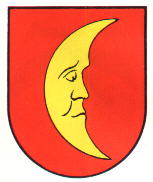Leiberstung: Difference between revisions
Jump to navigation
Jump to search
Knorrepoes (talk | contribs) m (Text replacement - "/Arms of " to "/Arms (crest) of ") |
Knorrepoes (talk | contribs) m (Text replacement - "{{media}}" to " {{de1}} {{media1}}") |
||
| Line 22: | Line 22: | ||
The oldest seal of Leiberstung dates from the early 19<sup>th</sup> century and shows in a crowned shield the crescent and the letters LST. The arms were officially approved in 1900 in the colours red and gold, to distinguish the arms from other municipalities with similar arms. The letters were removed. The meaning of the crescent is not known. | The oldest seal of Leiberstung dates from the early 19<sup>th</sup> century and shows in a crowned shield the crescent and the letters LST. The arms were officially approved in 1900 in the colours red and gold, to distinguish the arms from other municipalities with similar arms. The letters were removed. The meaning of the crescent is not known. | ||
{{ | |||
{{de1}} | |||
{{media1}} | |||
[[Civic Heraldry Literature - Germany|'''Literature''']]: Zier, 1964. | [[Civic Heraldry Literature - Germany|'''Literature''']]: Zier, 1964. | ||
Revision as of 11:02, 26 December 2022
This page is part of the German heraldry portal |
Heraldry of the World |
|
German heraldry:
|
Selected collector's items from Germany:
|
LEIBERSTUNG
State : Baden-Württemberg
District (Kreis) : Rastatt (until 1972 Bühl)
Incorporated into : 1973 Sinzheim
| German | In Rot ein abnehmender gebildeter goldener Halbmond. |
| English | No blazon/translation known. Please click here to send your (heraldic !) blazon or translation |
Origin/meaning
The oldest seal of Leiberstung dates from the early 19th century and shows in a crowned shield the crescent and the letters LST. The arms were officially approved in 1900 in the colours red and gold, to distinguish the arms from other municipalities with similar arms. The letters were removed. The meaning of the crescent is not known.
Literature: Zier, 1964.


